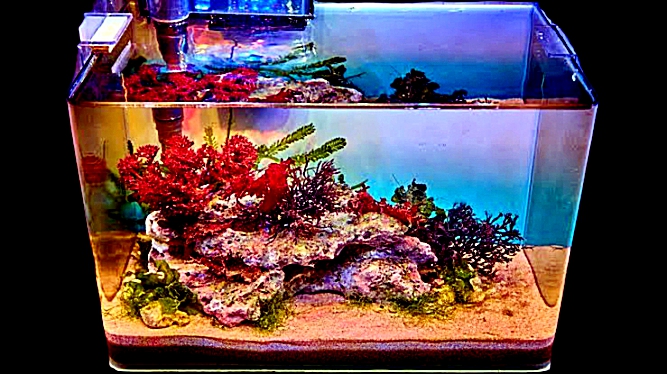What I find fascinating about pico tanks is how easy they are to move from place to place.
How I Prepare Saltwater and Live Rock
The first step is to mix the saltwater and have it prepared before adding it to the tank. This process also readies the water for the live rock. Next, I acquire the live rock.
I always visit Fish Guy Mike in Parsippany, New Jersey. He runs a business called Frags Galore out of his garage.
I recently went to his location to pick up my rock.
I enjoy visiting his establishment—it is always filled with great options and quality pieces.
Why I Use Cured Live Rock
When I get my live rock from Mike, it is already cycled. He has likely kept it in his system for years, so I have no need to go through the cycling process.
If you are getting live rock that was recently collected, exported, or has not gone through a proper cycle, then you cannot follow the same approach I used.
You would need to complete a 3- or 4-week period of testing for ammonia and nitrite to ensure the rock becomes fully cycled.
As soon as I bring the rock home, I unwrap it.
Parsippany is only about 15 minutes away, so I can take the rock out of its transport bag and place it directly into the saltwater.
Mike maintains his system temperature at around 75 to 76 degrees Fahrenheit.
The salinity is mixed to a specific gravity of 1.025, which is how he typically prepares his saltwater.
I have one piece of cured live rock with good coralline growth and sponges growing on it. I am particularly fond of it and plan to turn it into a shelf.
I may place coral on the shelf, depending on the layout I decide to create. I will likely use the same water from transport to pour directly into the tank.
How I Configure the Return Pump
To direct the flow back into the tank, I rigged the return pump by connecting a hose to the nano pump made by CJ and running it upward through a series of right-angle fittings. The fittings came from an overflow system, and the connection is leak-free because the hose runs continuously through them without any gaps.
For anyone planning a similar pico setup, it is important to know that the opening of my overflow box is only about 3 inches wide. I miscalculated the dimensions, as the opening is too narrow for my hand to fit inside and reach the bottom. This oversight, however, does not affect the tank’s function, since the only equipment in that space is a small pump. I plan to maintain a bare-bottom setup, and the pump’s placement will help keep the substrate stirred.
How I Add Water and Adjust Flow
I began adding saltwater to the tank. I only filled it halfway so it would remain light enough for me to lift and slide into its final position.
Some microbubbles formed, and the water created a bit of noise, but the flow felt strong.
I decided I might adjust the flow’s direction slightly by turning it to the left or right.
I rotated the pump by twisting the elbow joint, which allowed me to reposition it. After the adjustment, the air bubbles were directed toward the back of the pump instead of entering the main water flow.
What My Original Plan for the Tank Was
My original plan was to connect the pico tank to my 20-gallon tank in an inline setup.
I eventually abandoned the inline setup idea because I ran into too many issues with the return pump, head pressure, and other complications.
Instead, I sealed the overflow hole at the bottom and also closed off the return opening that leads back into the tank.
How to Set Up Lighting for a Pico Tank
I then added the live rock, which helped it settle and allowed me to gauge how the lighting would interact with the aquascape. For the lighting system, I chose the Kessil A80.
Initially, I had a box mounted on top of the tank. After testing the lighting, I realized I was not getting enough Photosynthetically Active Radiation with the original placement.
I made some adjustments to the top structure.
I had secured a rectangular piece with heavy-duty glue, and I removed it completely.
With the piece removed, the Kessil A80 simply rests on the square frame, which allows for better light penetration.
How to Test for Proper Photosynthetically Active Radiation Levels
I then performed a test for Photosynthetically Active Radiation, aiming for a reading of around 150, possibly a bit higher.
I used a meter for Photosynthetically Active Radiation because I wanted to set the Kessil A80 to a fixed level.
The light will turn on automatically through Wi-Fi and switch off at night, so I will not need to make further adjustments.
I ran the test and received readings of 150, 160, and 152, which fall within my target range.
A reading in this range works well for the type of coral I plan to keep.
I am not planning to keep any small polyp stony coral in this aquarium, so Photosynthetically Active Radiation levels in this range are perfectly acceptable.
How to Create a Stable Aquascape
I am a big fan of creating an aquascape that remains solid once it is inside the aquarium, so I use E-Marco 400 cement.
I planned to remove the rocks from the tank to secure them properly.
It took me about 45 minutes to cement the pieces together.
How to Position Rocks for Better Viewing
I wanted to position the top, flatter piece so it tilts slightly forward instead of sitting perfectly level.
When the rock is level, the viewing angle from a seated position makes it feel as if I am looking underneath it.
By tipping the rock forward, I can ensure that once I add coral, they will be easy to see while I am sitting down.
How to Make Cement Aquascapes Look Natural
I use a small piece of rock rubble to add texture with the wet cement.
I do not press too hard—I just apply enough pressure to imprint the surface, making it appear more natural.
I press it gently, almost like stamping, and I focus on the areas that will be visible.
I have also shared a more detailed explanation of my work with E-Marco cement in a separate walkthrough. In that guide, I offered a two-part, step-by-step breakdown of my process.
Conclusion
When I set up a pico reef tank, I start by mixing saltwater to a specific gravity of 1.025 and preparing cycled live rock. I prefer cured pieces from a trusted source so I can skip the usual 3- to 4-week period of testing for ammonia and nitrite.
I rig a small return pump by running a hose through right-angle fittings connected to an overflow box with an opening of about 3 inches, which ensures a consistent flow without any leaks.
I fill the tank halfway while it is still light enough to move, then rotate the pump elbow to redirect microbubbles away from the intake, keeping the water movement clean and steady.
I sealed off all overflow and return openings from my original inline plan to avoid problems with head pressure.
I positioned the live rock to tilt slightly forward so I can enjoy better visibility of coral when seated.
For lighting, I use the Kessil A80, placed directly on the frame after removing a previously mounted cover. The resulting configuration gives me around 150 Photosynthetically Active Radiation, confirmed with meter readings of 150, 160, and 152, and the light runs automatically on a Wi-Fi schedule.
I secure my aquascape using E-Marco 400 cement, adding natural texture by gently pressing in pieces of rock rubble. This method helps create a strong, realistic-looking structure that is ready for coral.

My name is Chibuzor Abraham Mba, and I’m the aquarist behind this website. I’ve spent years exploring the fascinating world of aquariums—especially small-scale tanks like nano and pico setups. Over time, I’ve made my fair share of mistakes, and through each one, I’ve learned valuable lessons.
